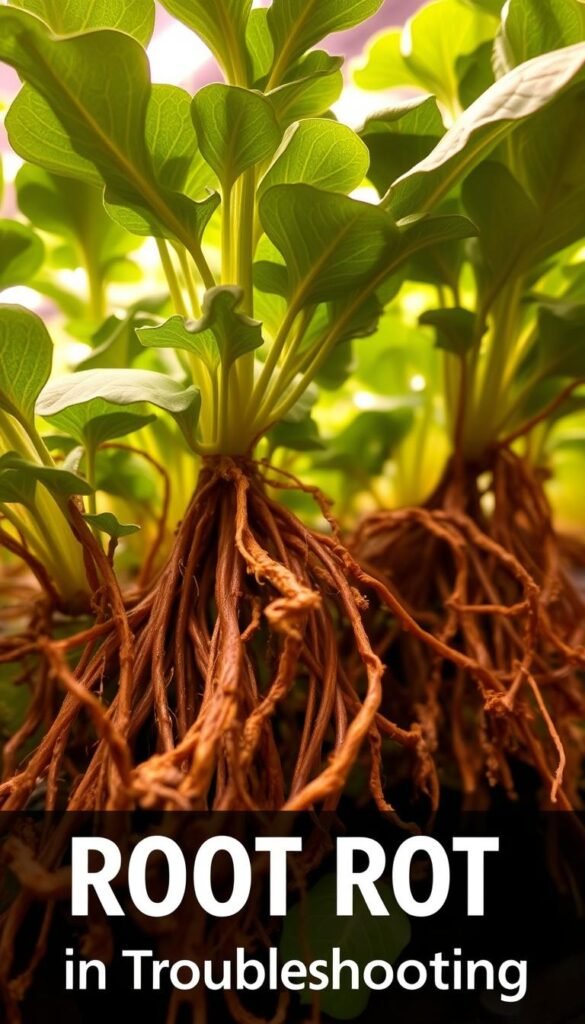If you’ve noticed dark, slimy roots in your hydroponic setup, you’re not alone. Discolored roots often signal a deeper issue that can threaten your plants’ health and harvest potential. Unlike soil gardening, hydroponics relies on precise oxygen and nutrient balance—and even small imbalances can trigger problems.
Root rot is a common culprit behind these symptoms. It thrives in stagnant water or poorly maintained systems, spreading pathogens that damage delicate root structures. Left unchecked, it reduces nutrient uptake and stunts growth. But don’t worry—early detection and targeted fixes can save your crops.
Successful hydroponic growth depends on three pillars: clean water, balanced nutrients, and proper aeration. Systems like deep water culture require extra attention to oxygen levels, while nutrient solutions need regular monitoring to avoid harmful buildups. Even small changes, like adjusting pH or cleaning reservoirs, make a big difference.
In this guide, you’ll learn how to spot early warning signs, address environmental stressors, and stop root rot before it spreads. We’ll break down actionable steps to keep your hydroponic system thriving—from simple daily checks to advanced prevention methods. Let’s get those roots back to peak health!
Understanding Hydroponic Systems and Root Health

Hydroponic gardening skips the soil, but that doesn’t mean it’s simpler than traditional methods. Instead of relying on earth’s natural buffers, your plants depend entirely on the environment you create. This precision is what makes hydroponics rewarding—and risky if basics like oxygen flow slip.
No Soil, No Problem—Just New Rules
In soil gardens, roots dig through dirt to find nutrients and air pockets. Hydroponics flips this: nutrients come dissolved in water, and you control their delivery. Without soil’s protective layer, roots are exposed to water 24/7. That’s why clean reservoirs and balanced pH matter more here.
Oxygen: The Silent Game-Changer
Healthy roots need oxygen as much as water. In traditional gardens, air circulates through soil. Hydroponic systems use aerators or air stones to pump bubbles into the water. Low oxygen levels starve roots, making them weak and prone to rot. A simple fix? Check your air pumps weekly—they’re your plants’ lifeline.
White, fuzzy roots mean your system works. Brown or slimy ones scream trouble. By mimicking nature’s balance—clean water, steady nutrients, and bubbly oxygen—you give plants what soil once did. It’s like being their personal chef and weatherman!
Identifying Root Rot and Brown Root Symptoms

Spotting unhealthy roots early can save your entire hydroponic garden. While some discoloration is normal—like tan stains from nutrient-rich water—true decay has distinct red flags. Let’s break down what to look for and why your system’s environment plays a starring role.
Visual and Sensory Signs in Your Plants
Healthy roots are firm and white, like fresh celery. Rotting ones turn brown or black, feel slimy, and smell like swamp water. If touching them leaves residue on your fingers, that’s a major warning. Leaves also tattle on root issues: yellow patches or sudden wilting often mean trouble below.
Don’t confuse staining from additives like humic acid with rot. Rinse roots gently—persistent discoloration and mushiness signal pathogens like Pythium. Check weekly, especially in warm setups where fungi thrive.
Environmental Factors That Contribute to Root Decay
Stagnant water is public enemy #1. Without proper oxygen flow, roots suffocate and invite infections. High water temps (above 75°F) speed up bacterial growth, while dirty equipment spreads spores. Even small debris in your reservoir can clog pumps and reduce circulation.
If your system struggles with common hydroponic issues, test dissolved oxygen levels first. Pair this with regular reservoir swaps to prevent salt buildups that stress plants. Remember: clean roots mean happy harvests!
Troubleshooting Brown Roots: Tips for Healthy Hydroponic Growth

When your plants start acting off, the answers often lie beneath the surface. A systematic approach helps uncover hidden issues before they spiral. Let’s walk through how to decode what’s happening in your setup.
A Step-by-Step Diagnostic Guide
Start by inspecting roots weekly. Healthy ones feel firm and springy—like fresh aloe vera gel. If they’re mushy or smell foul, pathogens might be partying in your reservoir. Next, check water clarity. Cloudy or oily films often mean bacteria are thriving.
Use this quick checklist:
- Test pH and nutrient levels daily—drastic swings stress plants
- Scrub reservoirs every 7-10 days with hydrogen peroxide
- Monitor water temps (65-70°F is ideal)
Spot an issue? Isolate affected plants immediately. Replace 50% of the water and add beneficial microbes to outcompete harmful strains. UV sterilizers work wonders for stubborn infections without chemicals.
Assessing Water Quality and Equipment Sanitation
Dirty pumps or clogged air stones create breeding grounds for trouble. Clean equipment with food-grade cleaners monthly. For persistent problems, ozone treatments can zap pathogens between grows.
| Parameter | Ideal Range | Test Frequency |
|---|---|---|
| pH | 5.5-6.5 | Daily |
| EC (Nutrient Strength) | 1.2-2.4 mS/cm | Every 3 Days |
| Dissolved Oxygen | >6 ppm | Weekly |
Consistency beats heroics. Small daily checks prevent 80% of issues. Remember—your plants can’t speak, but their roots always tell the truth!
Preventive Measures for a Healthy Hydroponic System

Prevention beats cure when managing hydroponic systems. A clean, well-balanced environment stops most issues before they start. Think of it like brushing your teeth—daily care avoids bigger problems down the line.
Regular Cleaning and Sanitization Procedures
Biofilms and debris love dirty reservoirs. Scrub tanks weekly with 3% hydrogen peroxide or food-grade cleaner. Don’t forget hoses and pumps—soak them monthly to remove mineral buildup. Daily tasks matter too:
- Skim dead leaves from water surfaces
- Check filters for clogs
- Wipe down grow trays
Follow hydroponic maintenance protocols to keep equipment sterile. Replace nutrient solutions every 7-10 days to avoid salt accumulation that stresses plants.
Maintaining Optimal Temperature and Aeration
Warm water is a pathogen’s playground. Keep reservoirs between 65-70°F—this range maximizes oxygen while slowing bacteria. Use aquarium chillers if room temps spike above 75°F. Pair this with strong air flow:
- Replace air stones every 6 months
- Position pumps above water level to prevent backflow
- Test dissolved oxygen weekly (aim for 6-8 ppm)
Flush systems monthly to remove decaying roots. Combine these steps, and you’ll create conditions where harmful microbes can’t thrive. Consistency here means fewer surprises—and more robust harvests!
Advanced Solutions: Water Chillers, Aerators, and Biofungicides

Upgrading your hydroponic system with smart tech can turn root rot risks into relics of the past. Modern tools like water chillers and biofungicides work together to create an environment where pathogens struggle to gain a foothold. Let’s explore how these innovations protect your plants while simplifying maintenance.
Selecting the Right Hydroponic Water Chiller
Water chillers from brands like North Slope Chillers keep nutrient solutions between 65-68°F—the sweet spot for slowing bacterial growth. Look for models with:
- Energy-efficient compressors (saves $ long-term)
- Easy-clean titanium coils (resists corrosion)
- Adjustable thermostats (±1°F precision)
For deep water culture setups, pair chillers with high-output aerators. More bubbles mean higher oxygen levels, which strengthens roots and starves anaerobic microbes. Check this comparison of popular chillers:
| Model | Capacity (Gal) | Key Feature |
|---|---|---|
| Cold Shot CL-85 | 85 | Quiet operation |
| Active Aqua 1/10 HP | 100 | Digital display |
| Ecoplus 1/4 HP | 150 | Heavy-duty pump |
Utilizing Biofungicides and Beneficial Microbes
Biofungicides like Root Guardian introduce Bacillus amyloliquefaciens—a bacteria that outcompetes harmful fungi. These products:
- Break down decaying organic matter
- Boost root immunity naturally
- Work in any grow medium (clay pellets, rockwool)
Pair them with mycorrhizal fungi for a 1-2 punch against hydroponic root rot. Apply every 2 weeks or after reservoir changes. This proactive way reduces chemical use while keeping your system balanced.
By blending tech with biology, you create a fortress against root issues. Start small—try a chiller in summer months or add microbes during nutrient swaps. Your plants will thank you with vigorous growth!
Final Thoughts on Optimizing Your Hydroponic Growth
A thriving hydroponic garden starts with vigilant monitoring and swift action. Catching root rot symptoms early—like unusual sliminess or discoloration—lets you tackle pathogens like Pythium before they overwhelm your plants. Pair routine reservoir cleaning with precise temperature control (65-70°F) to create an environment where harmful microbes struggle.
Your nutrient solution is the system’s heartbeat. Test it daily, adjust pH levels, and refresh it weekly to prevent imbalances. Integrate tools like water chillers and aerators to boost oxygen in water culture setups, giving roots the edge against decay.
Stay curious! Hydroponics evolves constantly, with new solutions emerging yearly. Whether refining your cleaning routine or experimenting with beneficial microbes, small tweaks lead to big wins. With consistency and attention to detail, you’ll turn challenges into lush, vibrant harvests. Your plants are ready to thrive—now go make it happen!






